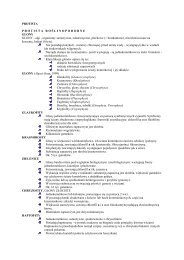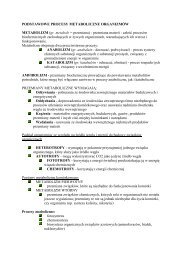Hair Shaft Abnormalities – Clues to Diagnosis and Treatment
Hair Shaft Abnormalities – Clues to Diagnosis and Treatment
Hair Shaft Abnormalities – Clues to Diagnosis and Treatment
You also want an ePaper? Increase the reach of your titles
YUMPU automatically turns print PDFs into web optimized ePapers that Google loves.
Fax +41 61 306 12 34<br />
E-Mail karger@karger.ch<br />
www.karger.com<br />
Review<br />
Derma<strong>to</strong>logy 2005;211:63<strong>–</strong> 71<br />
DOI: 10.1159/000085582<br />
<strong>Hair</strong> <strong>Shaft</strong> <strong>Abnormalities</strong> <strong>–</strong><br />
<strong>Clues</strong> <strong>to</strong> <strong>Diagnosis</strong> <strong>and</strong> <strong>Treatment</strong><br />
a, b b<br />
Peter H. Itin Susanna K. Fistarol<br />
a Department of Derma<strong>to</strong>logy, University Hospital Basel, Basel , <strong>and</strong> b Department of Derma<strong>to</strong>logy,<br />
Kan<strong>to</strong>nsspital Aarau, Aarau , Switzerl<strong>and</strong><br />
Key Words<br />
<strong>Hair</strong> shaft disorders <strong>Hair</strong> dysplasias Ec<strong>to</strong>dermal<br />
dysplasia Genetic predisposition Physical<br />
examination<br />
Abstract<br />
<strong>Hair</strong> dysplasias are congenital or acquired alterations<br />
which often involve the hair shaft. <strong>Hair</strong> shaft abnormalities<br />
are characterized by changes in color, density, length<br />
<strong>and</strong> structure. <strong>Hair</strong> shaft alterations often result from<br />
structural changes within the hair fi bers <strong>and</strong> cuticles<br />
which may lead <strong>to</strong> brittle <strong>and</strong> uncombable hair. The hair<br />
of patients with hair shaft diseases feels dry <strong>and</strong> looks<br />
lusterless. <strong>Hair</strong> shaft diseases may occur as localized or<br />
generalized disorders. Genetic predisposition or exogenous<br />
fac<strong>to</strong>rs produce <strong>and</strong> maintain hair shaft abnormalities.<br />
<strong>Hair</strong> shaft diseases are separated in<strong>to</strong> those with<br />
<strong>and</strong> those without increased hair fragility. In general, optic<br />
microscopy <strong>and</strong> polarized light microscopy of hair<br />
shafts provide important clues <strong>to</strong> the diagnosis of isolated<br />
hair shaft abnormalities or complex syndromes. To<br />
establish an exact diagnosis of dysplastic hair shafts, a<br />
structured his<strong>to</strong>ry <strong>and</strong> physical examination of the whole<br />
patient are needed which emphasizes other skin appendages<br />
such as the nails, sweat <strong>and</strong> sebaceous gl<strong>and</strong>s. Profound<br />
knowledge on hair biology <strong>and</strong> embryology is necessary<br />
<strong>to</strong> underst<strong>and</strong> the different symp<strong>to</strong>m complexes.<br />
Therapy of hair shaft disorders should focus on the<br />
© 2005 S. Karger AG, Basel<br />
1018<strong>–</strong>8665/05/2111<strong>–</strong>0063$22.00/0<br />
Accessible online at:<br />
www.karger.com/drm<br />
cause. In addition, minimizing traumatic infl uences <strong>to</strong><br />
hair shafts, such as drying hair with an electric dryer or<br />
permanent waves <strong>and</strong> dyes, is important. A short hairstyle<br />
is more suitable for patients with hair shaft disorders.<br />
Introduction<br />
Copyright © 2005 S. Karger AG, Basel<br />
Although hair has no vital function, it may serve as an<br />
indica<strong>to</strong>r for human health. Clinical <strong>and</strong> morphological<br />
hair abnormalities can be clues <strong>to</strong> specifi c complex disorders.<br />
The human hair form <strong>and</strong> the diameter are determined<br />
by the ana<strong>to</strong>my of the hair follicle [1] . Changes in<br />
the hair shaft can occur physiologically such as in pregnancy<br />
but in general mirror a disease process. Nissimov<br />
<strong>and</strong> Elchalal [2] described for the fi rst time that hair diameter<br />
increases during a normal physiological process.<br />
Anomalies of the hair shaft are separated in<strong>to</strong> those with<br />
<strong>and</strong> those without increased hair fragility. <strong>Hair</strong> shaft abnormalities<br />
can be inherited or acquired, can refl ect a local<br />
problem or a systemic disease ( table 1 ). It is important<br />
<strong>to</strong> know whether the hairs do never grow, or whether a<br />
defect in the hair cycle exists such as in the anagen, limiting<br />
the duration of hair growth. The fact that alopecia in<br />
a given case is caused by hair which is falling out <strong>to</strong> light<br />
traction while still growing may be a clue for loose anagen<br />
hair syndrome.<br />
Peter H. Itin<br />
Department of Derma<strong>to</strong>logy<br />
Kan<strong>to</strong>nsspital Aarau<br />
CH<strong>–</strong>5001 Aarau (Switzerl<strong>and</strong>)<br />
Tel. +41 62 638 6952, Fax +41 62 638 6953, E-Mail peter.itin@unibas.ch
Table 1. Features of hair shaft diseases<br />
Classifi cation<br />
Acquired or congenital<br />
Exogenous or genetic<br />
Diffuse or localized<br />
Clinical aspect<br />
Dry hair <strong>and</strong> lusterless<br />
Uncombable hair<br />
Fair hair<br />
Breaks easily<br />
<strong>Diagnosis</strong><br />
His<strong>to</strong>ry<br />
Physical examination<br />
Light <strong>and</strong> scanning electron microscopy<br />
Biochemical analysis<br />
Most of the genotrichoses show a Mendelian trait of<br />
inheritance. However, some are non-Mendelian phenotypes<br />
representing lethal mutations surviving only by mosaicism.<br />
These traits may follow paradominant inheritance<br />
as emphasized by Happle <strong>and</strong> König [3] . There are<br />
polygenic <strong>and</strong> monogenic hair disorders. ‘Online Mendelian<br />
inheritance in man’ gives 66 entries for hypotrichosis<br />
<strong>and</strong> 153 entries for alopecia which illustrates the heterogeneity<br />
of the problem.<br />
In the daily work, a clinical classifi cation of alopecia<br />
which also includes hair shaft abnormalities as proposed<br />
by Happle seems reasonable: (1) <strong>to</strong>tal or sub<strong>to</strong>tal absence<br />
of scalp hair in early childhood, (2) more or less diffuse<br />
hypotrichosis that may or may not deteriorate during life<br />
or even diminish, (3) absence of hair in distinctly demarcated<br />
patches or streaks [4] . Complex systemic diseases<br />
may lead <strong>to</strong> typical hair shaft alterations such as trichorrhexis<br />
nodosa, trichorrhexis invaginata <strong>and</strong> trichoschisis<br />
( fi g. 1 , 2 ). <strong>Hair</strong> shaft disorders include ‘uncombable hair’<br />
with a triangular <strong>and</strong> canalicular diameter ( fi g. 3 , 4 ).<br />
64<br />
Embryology <strong>and</strong> Biochemistry of <strong>Hair</strong><br />
<strong>Hair</strong> is an ec<strong>to</strong>dermal structure, <strong>and</strong> its formation is<br />
regulated by master genes important in embryology. The<br />
mammalian hair follicle develops from the epidermis [5] .<br />
The major biochemical components of human hair are<br />
the intermediate fi laments or keratins <strong>and</strong> the keratin-associated<br />
proteins [6] . Keratins belong <strong>to</strong> the superfamily<br />
of proteins that form 8- <strong>to</strong> 10-nm fi laments in the cy<strong>to</strong>plasm<br />
of many epithelial cells. The terminology for human<br />
hair basic keratins is abbreviated internationally as<br />
Derma<strong>to</strong>logy 2005;211:63<strong>–</strong>71<br />
Fig. 1. Trichorrhexis nodosa.<br />
Fig. 2. Trichorrhexis invaginata.<br />
‘hHb’ [7] . Keratin-associated proteins are divided in<strong>to</strong><br />
two groups, high-cyst(e)ine <strong>and</strong> high glycine-tyrosine-rich<br />
polypeptides, according <strong>to</strong> the amino acid composition.<br />
Cyst(e)ine-rich keratins contain high-sulfur (15<strong>–</strong>30%)<br />
proteins <strong>and</strong> ultra-high-sulfur proteins composed of 1 30%<br />
cyst(e)ine residues [8] . A trichohyalin gene is only characterized<br />
in rabbits so far, <strong>and</strong> further work is necessary<br />
<strong>to</strong> unravel the human homologue [9] .<br />
Syndromes with ec<strong>to</strong>dermal malformations often<br />
show altered hair shafts. Almost 200 different entities out<br />
of the spectrum of ec<strong>to</strong>dermal dysplasias are known <strong>to</strong>day.<br />
In many cases of ec<strong>to</strong>dermal <strong>and</strong>/or mesodermal disorders,<br />
the developmental anomalies of other organs predominate<br />
those of the hair.<br />
Itin /Fistarol
Fig. 3. Pili trianguli.<br />
Fig. 4. Pili canaliculi.<br />
Fig. 5. Dysplastic hair in KID syndrome.<br />
<strong>Hair</strong> <strong>Shaft</strong> Alterations <strong>and</strong> the<br />
Dysmorphologist<br />
<strong>Hair</strong> changes may be a signifi cant fi nding or even the<br />
initial presentation of a syndrome giving the clue <strong>to</strong> the<br />
diagnosis, e.g. trichothiodystrophy (TTD). Clinically hair<br />
in these syndromes may be sparse, slow growing, fragile<br />
<strong>and</strong> brittle, uncombable, dry <strong>and</strong> lusterless. The hair color<br />
may give further information on the existence of genetic<br />
disorders with hair shaft anomalies. Clinical diagnosis<br />
in dysmorphology is often like a puzzle, <strong>and</strong> numerous<br />
s<strong>to</strong>nes help <strong>to</strong> complete the whole picture. <strong>Hair</strong><br />
morphology as a <strong>to</strong>ol for the diagnosis of genetic diseases<br />
has been recognized by dysmorphologists [10] . In KID<br />
syndrome (kera<strong>to</strong>sis, ichthyosis <strong>and</strong> deafness), more than<br />
90% of patients have alopecia often associated with hair<br />
shaft alterations [11] ( fi g. 5 ). To investigate hair shaft disorders,<br />
about 50 hairs should be visualized under light<br />
microscopy. There are exceptions such as Nether<strong>to</strong>n’s<br />
syndrome where repeated samples of hairs may be necessary<br />
<strong>to</strong> confi rm the diagnosis. The hair sampling should<br />
be performed where clinical hair abnormalities are most<br />
prominent. There are hair shaft disorders which have<br />
more impressive changes in the occipital area because of<br />
maximal trauma such as in TTD <strong>and</strong> monilethrix. It is<br />
important <strong>to</strong> compare normal <strong>and</strong> affected hairs. In patients<br />
with hair shaft diseases, hair should be cut just<br />
above the scalp <strong>to</strong> make sure that weathering of hair<br />
which is found on the distal parts does not interfere. In<br />
case no hair shaft alteration is found, alopecia could result<br />
from a defect in the hair cycling process, <strong>and</strong> therefore in<br />
such cases hair should be plucked by a pair of forceps with<br />
rubber or plastic tubing over the tips as in loose anagen<br />
hair syndrome or in dystrophic anagen hair. Examination<br />
under light <strong>and</strong> scanning electron microscopes is an important<br />
step in the diagnosis of hair shaft disorders. A<br />
diagnostic clue for breaking hair is a brush on the distal<br />
end of the shaft. An important question is also whether<br />
cuticles are normal, sparse or even lacking.<br />
<strong>Hair</strong> <strong>Shaft</strong> Alterations in Ec<strong>to</strong>dermal<br />
Dysplasias<br />
Ec<strong>to</strong>dermal dysplasias are a large group of heritable<br />
conditions characterized by congenital defects of one or<br />
more ec<strong>to</strong>dermal structures [12] . Selvaag et al. [13] investigated<br />
hair samples of patients with various ec<strong>to</strong>dermal<br />
dysplasias such as hypohidrotic ec<strong>to</strong>dermal dysplasia,<br />
pachyonychia congenita, trichoden<strong>to</strong>-osseous syndrome<br />
<strong>Hair</strong> <strong>Shaft</strong> <strong>Abnormalities</strong> Derma<strong>to</strong>logy 2005;211:63<strong>–</strong>71 65
<strong>and</strong> trichorhinophalangeal syndrome by scanning electron<br />
microscopy. The hairs of those patients showed<br />
twisting, longitudinal grooves, trichorrhexis nodosa <strong>and</strong><br />
variations in hair caliber.<br />
X-linked hypohidrotic ec<strong>to</strong>dermal dysplasia is characterized<br />
by hypotrichosis with fi ne, slow-growing scalp <strong>and</strong><br />
body hair, sparse eyebrows, hypohidrosis, nail anomalies<br />
<strong>and</strong> hypodontia [14] . The hair is sparse, dry, lusterless<br />
<strong>and</strong> light colored. Rogers [15] observed that the bar code<br />
appearance which mirrors a microscopic artifact is often<br />
seen in patients with hypohidrotic ec<strong>to</strong>dermal dysplasia.<br />
There are parallel dark b<strong>and</strong>s of different lengths running<br />
across the full width of the hair shaft. Kere et al. [16]<br />
found mutations in ec<strong>to</strong>dysplasin, a TNF lig<strong>and</strong>, <strong>to</strong> be the<br />
cause of the X-linked hypohidrotic ec<strong>to</strong>dermal dysplasia.<br />
The ec<strong>to</strong>dysplasin pathway, a new TNF pathway, has an<br />
important function in embryonic development <strong>and</strong> especially<br />
in the formation of ec<strong>to</strong>dermal structures including<br />
hair. Mutations in the human homologue of the mouse<br />
downless (dl) gene cause au<strong>to</strong>somal recessive or dominant<br />
hypohidrotic ec<strong>to</strong>dermal dysplasia [17] .<br />
Ectrodactyly, ec<strong>to</strong>dermal dysplasia <strong>and</strong> cleft palate<br />
(EEC) syndrome has initially been described in 1804.<br />
Since then the clinical spectrum has been further delineated.<br />
EEC syndrome is an au<strong>to</strong>somal dominant trait involving<br />
ec<strong>to</strong>dermal <strong>and</strong> mesodermal tissue. Marked scalp<br />
dermatitis may occur early in the disease [18, 19] . Scarring<br />
folliculitis in a 16-year-old boy was observed by<br />
Trüeb et al. [20] . They documented reduced hair elasticity<br />
indicating either an abnormal composition or a disordered<br />
arrangement of microfi brils within the apparently<br />
normal keratin matrix. <strong>Hair</strong> is affected in all cases. <strong>Hair</strong><br />
is light colored, coarse <strong>and</strong> dry. Axillary <strong>and</strong> pubic hair<br />
may be sparse. An increase in hair pigmentation with age<br />
has been observed. A germline missense mutation in the<br />
p63 gene underlying EEC syndrome has been reported<br />
[21] . Heterozygous germline mutations in the p53 homologue<br />
p63 are critical for maintaining the progeni<strong>to</strong>r cell<br />
populations that are necessary <strong>to</strong> sustain epithelial development,<br />
limb <strong>and</strong> craniofacial morphogenesis [22, 23] .<br />
AEC syndrome is inherited in an au<strong>to</strong>somal dominant<br />
fashion <strong>and</strong> st<strong>and</strong>s for ankyloblepharon, ec<strong>to</strong>dermal defects<br />
<strong>and</strong> clefting of the lip <strong>and</strong> palate [24] . It is allelic<br />
with the EEC syndrome <strong>and</strong> can be distinguished by the<br />
presence of lobster type malformations of the h<strong>and</strong>s <strong>and</strong><br />
feet.<br />
Pili trianguli et canaliculi may appear as isolated uncombable<br />
hair syndrome, but associations with other ec<strong>to</strong>dermal<br />
malformations may occur. Uncombable hair<br />
syndrome is characterized by scalp hairs arranged in bun-<br />
66<br />
Derma<strong>to</strong>logy 2005;211:63<strong>–</strong>71<br />
dles in all directions, resistant <strong>to</strong> brush <strong>and</strong> comb. <strong>Hair</strong><br />
diameter in this condition shows a triangular <strong>to</strong> reniform<br />
<strong>to</strong> heart shape aspect on cross-sections, <strong>and</strong> a groove, canal<br />
or fl attening along the entire length of the hair in at<br />
least 50% of hairs examined by scanning electron microscopy<br />
[25] . Several entities may lead <strong>to</strong> uncombable spunglass<br />
hair. As a rule, the syndrome becomes obvious during<br />
the fi rst years of life. The hair is normal in quantity,<br />
but dry <strong>and</strong> silvery blond. Increased fragility is not common.<br />
Trichorhinophalangeal syndrome is inherited as an<br />
au<strong>to</strong>somal dominant trait <strong>and</strong> clinically characterized by<br />
growth retardation, craniofacial abnormalities, severe<br />
brachydactyly, pear-shaped nose, elongated philtrum,<br />
thin upper lip <strong>and</strong> sparse <strong>and</strong> slow-growing hair with hair<br />
shaft alterations. In addition, mental retardation <strong>and</strong> cartilaginous<br />
exos<strong>to</strong>ses may occur depending on the type of<br />
the syndrome.<br />
Cartilage-hair hypoplasia, also called McKusick type<br />
metaphyseal chondrodysplasia, is an au<strong>to</strong>somal recessive<br />
skeletal dysplasia with disproportionate short stature, alopecia<br />
<strong>and</strong> metaphyseal abnormalities in skeletal radiographs.<br />
<strong>Hair</strong> is fi ne, sparse, light colored with sparse eyebrows<br />
<strong>and</strong> eyelashes. Other common features are a defective<br />
immunity <strong>and</strong> an increased risk for malignancies.<br />
The major mutation causing cartilage-hair hypoplasia is<br />
a nucleotide substitution in the ribonuclease mi<strong>to</strong>chondrial<br />
RNA gene which encodes the untranslated RNA<br />
that is a component of mi<strong>to</strong>chondrial RNA-processing<br />
endoribonuclease [26] .<br />
Nether<strong>to</strong>n’s syndrome is a rare ( ! 1: 100,000) au<strong>to</strong>somal<br />
recessive disease characterized by hair shaft defects, ichthyosis<br />
<strong>and</strong> a<strong>to</strong>py. 18% of 51 cases with neonatal <strong>and</strong> infantile<br />
erythrodermas were fi nally diagnosed as Nether<strong>to</strong>n’s<br />
syndrome [27] . The main hair abnormality in Nether<strong>to</strong>n’s<br />
syndrome was initially named bamboo hair <strong>and</strong><br />
later called trichorrhexis invaginata. Less specifi c hair abnormalities<br />
are <strong>to</strong>rsions, trichorrhexis nodosa <strong>and</strong> helical<br />
hairs. However in the neonatal period, hair shaft anomalies<br />
can still be lacking which makes an early diagnosis<br />
rather diffi cult [28] . Sometimes the diagnosis of the hair<br />
shaft anomalies is easier <strong>to</strong> perform in the eyebrows than<br />
on scalp hair [29] . The typical trichorrhexis invaginata is<br />
easily recognized under light microscopy, although scanning<br />
electron microscopy gives a nicer picture. Chavanas<br />
et al. [30] mapped the disease <strong>to</strong> chromosome 5q32 by linkage<br />
analysis <strong>and</strong> homozygosity demonstrated in 20 families<br />
with Nether<strong>to</strong>n’s syndrome. The same group fi nally<br />
found mutations in SPINK5, encoding a serine protease<br />
inhibi<strong>to</strong>r as the cause for Nether<strong>to</strong>n’s syndrome [31] .<br />
Itin /Fistarol
Trichothiodystrophy (TTD) is a heterogeneous group<br />
of au<strong>to</strong>somal recessive disorders with distinctive features<br />
of short, brittle hair <strong>and</strong> abnormally low-sulfur content [9] .<br />
The hair of patients with TTD is dry <strong>and</strong> sparse, <strong>and</strong> the<br />
hair shafts break easily with trauma. Environmental fac<strong>to</strong>rs<br />
<strong>and</strong> mechanical stress play an important role. Interestingly,<br />
intermittent hair loss during infections was observed<br />
by Kleijer et al. [32] <strong>and</strong> Foulc et al. [33] . In addition, hair<br />
loss may occur with periodic cyclicity. Fractures of the hair<br />
shaft develop, <strong>and</strong> the viscoelastic parameters of hair are<br />
compromised compared <strong>to</strong> controls. Within the spectrum<br />
of the TTD syndromes are numerous interrelated neuroec<strong>to</strong>dermal<br />
disorders. The TTD syndromes show defective<br />
synthesis of high-sulfur matrix proteins. <strong>Abnormalities</strong><br />
in nucleotide excision repair of ultraviolet-damaged<br />
DNA exist in about half of the patients. Three complementation<br />
groups have been characterized among pho<strong>to</strong>sensitive<br />
patients with TTD. Most patients have mutations on<br />
the two alleles of the XPD gene. Rarely, mutated XPB gene<br />
or TTD-A gene may result in TTD. In UV-sensitive TTD<br />
patients, the TFIIH transcription fac<strong>to</strong>r containing XPB<br />
<strong>and</strong> XPD helicase activities necessary for both transcription<br />
initiation <strong>and</strong> DNA repair is damaged. Beyond defi -<br />
ciency in the nucleotide excision repair pathway, basal<br />
transcription is altered leading <strong>to</strong> decreased transcription<br />
of specifi c genes. Depressed RNA synthesis is probably<br />
responsible for some clinical features, such as growth retardation,<br />
neurological abnormalities <strong>and</strong> brittle hair <strong>and</strong><br />
nails. In patients with TTD hair abnormalities are the only<br />
obliga<strong>to</strong>ry <strong>and</strong> diagnostic fi ndings that identify the sulfurdefi<br />
cient neuroec<strong>to</strong>dermal dysplasias. Scalp hairs, eyebrows<br />
<strong>and</strong> eyelashes are brittle, unruly, of variable lengths,<br />
easily broken <strong>and</strong> generally feel dry. It is important <strong>to</strong> investigate<br />
the proximal parts of hair shafts, as the distal<br />
portions often show marked weathering that may produce<br />
fi ndings similar <strong>to</strong> TTD [34] . Macroscopic alterations are<br />
observed especially in the occipital hair, where microscopic<br />
abnormalities are best visible. For adequate diagnosis,<br />
hairs should be collected from different areas of the scalp<br />
<strong>and</strong> subjected <strong>to</strong> further light- <strong>and</strong> electron-microscopic<br />
examination [35, 36] . Light microscopy reveals clean<br />
transverse fractures through the hair shafts (trichoschisis),<br />
<strong>and</strong> there is an irregular hair surface <strong>and</strong> diameter. In addition,<br />
a decreased cuticular layer with twisting <strong>and</strong> a nodal<br />
appearance may mimic trichorrhexis nodosa. The distal<br />
hair shaft often terminates in ‘brush breaks’. The fl attened<br />
hair shafts tend <strong>to</strong> fold over like a ribbon or shoe lace during<br />
microscopic mounting. This abrupt 180-degree twist<br />
of the hair shaft mimics pili <strong>to</strong>rti. Polarizing microscopy<br />
with crossed polarizers shows the typical appearance of<br />
alternating light <strong>and</strong> dark b<strong>and</strong>s, giving a ‘zigzag’ or ‘tiger<br />
tail’ pattern. Brusasco <strong>and</strong> Restano [37] reported the interesting<br />
fi nding that the typical tiger tail pattern of the<br />
hair shaft in TTD may not be evident at birth. This classical<br />
pattern was clearly evident only at 3 months of age<br />
in their case. However, hair examination from a 21-week<br />
gestation, aborted fetus showed the alternating light <strong>and</strong><br />
dark b<strong>and</strong>ing pattern under the polarized light microscope<br />
[38] . Within the last few years, it has been shown that the<br />
tiger tail pattern on polarized hair microscopic examination<br />
may also be found in healthy infants, <strong>and</strong> therefore<br />
amino acid analysis quantitating sulfur <strong>–</strong> specifi cally<br />
cyst(e)ine) levels <strong>–</strong> remains the defi nitive test for TTD [39,<br />
40] . In this regard, Garcia-Hern<strong>and</strong>ez et al. [41] have documented<br />
alternating dark <strong>and</strong> white zones within the hair<br />
shaft of a young patient who scratched his scalp intensely.<br />
Cessation of scratching <strong>and</strong> application of minoxidil 2%<br />
<strong>and</strong> cysteine therapy resulted in marked improvement<br />
within a year. The condition appears suffi ciently different<br />
by polarizing light microscopy, <strong>and</strong> this sulfur-defi cient<br />
hair alteration is referred <strong>to</strong> as ‘pseudo tiger-tailing’. Sperling<br />
<strong>and</strong> Di Giovanna [42] noticed that fi bers within the<br />
hair shafts of patients with TTD undulate up <strong>and</strong> down<br />
(or back <strong>and</strong> forth), a feature that is easily observed because<br />
of melanin granules embedded in each fi ber. The<br />
undulations corresponded exactly <strong>to</strong> the b<strong>and</strong>ing seen<br />
with polarization. Therefore, the tiger tail phenomenon<br />
seen in TTD <strong>and</strong> other hair shaft disorders was interpreted<br />
<strong>to</strong> be caused by a regular undulation of hair fi bers within<br />
the shafts. Normal hair shafts do not show the phenomenon<br />
because the hair fi bers are straight <strong>and</strong> parallel <strong>to</strong> the<br />
long axis of the hair.<br />
Naxos disease is a recessively inherited arrythmogenic<br />
right ventricular cardiomyopathy caused by a mutation<br />
in the gene encoding plakoglobin (cell adhesion protein)<br />
in which the cardiac phenotype is associated with diffuse<br />
palmoplantar kera<strong>to</strong>derma <strong>and</strong> woolly hair [43] . Woolly<br />
hair associated with striate kera<strong>to</strong>derma <strong>and</strong> cardiomyopathy<br />
is called Carvajal disease <strong>and</strong> caused by a recessive<br />
deletion mutation in desmoplakin which links desmosomal<br />
adhesion molecules <strong>to</strong> intermediate fi laments<br />
of the cy<strong>to</strong>skele<strong>to</strong>n [44] .<br />
Metabolic Disorders <strong>and</strong> Neurological<br />
Syndromes with <strong>Hair</strong> <strong>Shaft</strong> Alterations<br />
Metabolic disorders with alopecia are numerous including<br />
multiple carboxylase defi ciency, homocystinuria,<br />
Hartnup disease, phenylke<strong>to</strong>nuria, citrullinemia, argini-<br />
<strong>Hair</strong> <strong>Shaft</strong> <strong>Abnormalities</strong> Derma<strong>to</strong>logy 2005;211:63<strong>–</strong>71 67
nosuccinase defi ciency, acrodermatitis enteropathica <strong>and</strong><br />
Menkes disease. Recently, abnormally fi ne, sparse <strong>and</strong><br />
slow-growing hair which lacked luster <strong>and</strong> was coarse in<br />
texture was reported in congenital disorders of glycosylation<br />
(CDG type 1) [45] . Light-microscopic investigations<br />
showed trichorrhexis nodosa <strong>and</strong> <strong>to</strong>rsion of the shaft<br />
along the longitudinal axis. CDG syndromes are a group<br />
of genetic, multisystemic disorders with au<strong>to</strong>somal recessive<br />
inheritance characterized by defective biosynthesis<br />
of the glycan moiety of glycoproteins.<br />
Classical Menkes disease or Menkes kinky hair syndrome<br />
is an X-linked recessive multisystemic disorder.<br />
Four types of Menkes disease can be distinguished. The<br />
severe classical form <strong>and</strong> the mildest, called occipital horn<br />
syndrome, comprise more than 90%. The two additional<br />
types are classifi ed as a moderate <strong>and</strong> a mild form. The<br />
latter two rather refl ect clinical transitions between Menkes<br />
disease <strong>and</strong> occipital horn syndrome than fully independent<br />
entities. As a rule, only males are affected although<br />
a few females have been reported <strong>to</strong> express the<br />
disease due <strong>to</strong> a variety of genetic defects within the Xchromosome.<br />
In more than 90%, the natural course of the<br />
disease leads <strong>to</strong> death in early infancy in affected males.<br />
In general, female carriers of the gene defect are phenotypically<br />
normal, but in 50% they do have hair shaft anomalies.<br />
The syndrome leads <strong>to</strong> progressive neurodegeneration,<br />
connective tissue abnormalities <strong>and</strong> abnormal hair.<br />
The color of the hair is most often reported as white, silver<br />
or gray, a result of marked reduction of melanin <strong>and</strong> an<br />
associated abundance of tyrosinase. Clinically the hair appears<br />
short, sparse, coarse, lusterless <strong>and</strong> twisted. <strong>Hair</strong><br />
shaft abnormalities include pili <strong>to</strong>rti <strong>and</strong> monilethrix,<br />
sometimes trichorrhexis <strong>and</strong> trichoptilosis. These structural<br />
changes are due <strong>to</strong> a defect in the copper-enzymedependent<br />
cross-linkage of disulfi de bonds in the hair’s<br />
keratin. <strong>Diagnosis</strong> is made by documenting low serum<br />
copper (below 25% of normal range) <strong>and</strong> low ceruloplasmin<br />
levels. Menkes disease is due <strong>to</strong> a defect in the copper<br />
homeostasis <strong>and</strong> transport system. ATP7A encodes for<br />
the copper-binding enzyme ATPase which is essential for<br />
intracellular copper transport <strong>and</strong> metabolism [46] .<br />
Giant axonal neuropathy is an au<strong>to</strong>somal recessive<br />
condition characterized by progressive degeneration of<br />
the central <strong>and</strong> peripheral nervous system. Children have<br />
curly hair <strong>and</strong> characteristic pilar alterations with pseudo-pili<br />
<strong>to</strong>rti aspect occurring early in life before neuropathy<br />
is clinically present. Therefore hair abnormalities<br />
have an important diagnostic impact [47] . Recently, a<br />
defective protein, gigaxonin, has been identifi ed, <strong>and</strong> different<br />
pathogenic mutations in the gigaxonin gene have<br />
68<br />
Derma<strong>to</strong>logy 2005;211:63<strong>–</strong>71<br />
Fig. 6. Monilethrix.<br />
been reported as the underlying genetic defect. Gigaxonin<br />
seems <strong>to</strong> play a crucial role in the cross-talk between the<br />
intermediate fi laments <strong>and</strong> the membrane network [48] .<br />
More than 30 cases of the Bjornstad syndrome (sensorineural<br />
deafness <strong>and</strong> pili <strong>to</strong>rti) have been reported since<br />
its description in 1965. The clinical spectrum is rather<br />
heterogeneous, <strong>and</strong> hypogonadism <strong>and</strong> mental retardation<br />
may be associated in this syndrome. Both au<strong>to</strong>somal<br />
dominant <strong>and</strong> recessive inheritance patterns may occur.<br />
The responsible gene was mapped <strong>to</strong> the gene locus 2q34<strong>–</strong><br />
q36 [49, 50] . As a rule, hair loss appears within the fi rst<br />
2 years of life <strong>and</strong> hearing loss develops in the fi rst 3<strong>–</strong>4<br />
years of life.<br />
Isolated Genetic <strong>Hair</strong> <strong>Shaft</strong> Alterations<br />
Monilethrix is a rare inherited defect of the hair shaft<br />
resulting in hair fragility <strong>and</strong> dystrophic alopecia. Follicular<br />
kera<strong>to</strong>sis especially in the occipital area is a prominent<br />
feature. In contrast <strong>to</strong> recent reports, mapping monilethrix<br />
<strong>to</strong> the type II epithelial <strong>and</strong> trichocyte keratin<br />
gene cluster on 12q13, we strongly excluded these c<strong>and</strong>idate<br />
genes in a family with au<strong>to</strong>somal dominant monilethrix<br />
( fi g. 6 ) [51] .<br />
Pili anulati (PA) are a rare hair shaft disorder characterized<br />
by discrete b<strong>and</strong>ing of hairs. There have been multiple<br />
reports of familial PA, segregating in an au<strong>to</strong>somal<br />
dominant fashion. A locus for PA at the telomeric region<br />
of chromosome 12q has been shown [52] . PA are defi ned<br />
by characteristic alternating light <strong>and</strong> dark b<strong>and</strong>ing in the<br />
hair shaft, due <strong>to</strong> air-fi lled spaces between the macrofi brillar<br />
units of the hair cortex, <strong>and</strong> are regarded as a congenital<br />
hair shaft disorder without increased hair fragility.<br />
However Günther et al. [53] observed that with onset of<br />
hair thinning due <strong>to</strong> <strong>and</strong>rogenetic alopecia, progressive<br />
reduction of hair shaft diameter may cause increased fragility<br />
in PA.<br />
Itin /Fistarol
Fig. 7. <strong>Hair</strong> shaft encircled with lacquer.<br />
Fig. 8. <strong>Hair</strong> cast.<br />
Multiple twisted <strong>and</strong> rolled body hairs that may develop<br />
in<strong>to</strong> multiple large knots may appear as a minor<br />
variant of hair matting or felting. Scanning electron microscopy<br />
shows multiple hairs that originate from different<br />
hair follicles <strong>and</strong> roll <strong>and</strong> stick <strong>to</strong>gether centrally [54] .<br />
A genetic trait has been discussed.<br />
Pili bifurcati is a rare hair shaft dysplasia with bifurcation<br />
of the hair shaft. The two characteristics that defi ne<br />
the dysplasia are the fact that each bifurcation produces<br />
two separate parallel branches fusing again <strong>to</strong> form a single<br />
shaft, <strong>and</strong> that each branch of the successive bifurcations<br />
is covered with its own cuticle. In contrast, papillar<br />
tips that divide in<strong>to</strong> several tips will produce multiple hair<br />
shafts that do not fuse again [55] .<br />
Pili multigemini is a developmental defect of hair follicles<br />
resulting from hairs with multiple matrices <strong>and</strong> papillae<br />
originating through one single pilosebaceous canal<br />
[56] . Linear distribution according <strong>to</strong> the lines of Blaschko<br />
may occur. Ring hair may be observed as isolated hair<br />
changes but also occurs with palmoplantar kera<strong>to</strong>derma<br />
[57] .<br />
Acquired <strong>Hair</strong> <strong>Shaft</strong> Alterations<br />
Acquired hair shaft alterations by cosmetic procedures<br />
are common. Various cosmetic products affect hair color<br />
<strong>and</strong> texture <strong>and</strong> can lead <strong>to</strong> structural alterations in the<br />
hair shaft. Clinical damage <strong>to</strong> the hair shaft occurs with<br />
the application of hair dye. <strong>Hair</strong> returns <strong>to</strong> its precoloring<br />
state <strong>and</strong> this requires 8 weeks [58] . <strong>Hair</strong> changes can occur<br />
by lacquer <strong>and</strong> gel application. Light microscopy may<br />
demonstrate that the hairs are encircled by a material<br />
with a glassy appearance that seems <strong>to</strong> splinter at several<br />
points ( fi g. 7 ). Scanning electron microscopy shows that<br />
the hairs are encased by a glue-like material, <strong>and</strong> under<br />
the lacquer normal cuticles are visible. Cosmetically induced<br />
hair shaft disorders are numerous <strong>and</strong> include matting<br />
of scalp hair, bubble hair <strong>and</strong> trichorrhexis nodosa.<br />
<strong>Hair</strong> sprays often contain polyvinylpyrrolidone <strong>and</strong> vinyl<br />
acetate. <strong>Hair</strong> styling gels <strong>and</strong> sculpturing gels have an extremely<br />
high-hold effect especially if they contain methacrylate<br />
copolymers [59] .<br />
<strong>Hair</strong> casts are characterized by white keratinous material<br />
adherent <strong>to</strong> hair shafts, <strong>and</strong> they can look very similar<br />
<strong>to</strong> nits from an infestation with Pediculus capitis ( fi g. 8 ).<br />
In contrast <strong>to</strong> nits, the small cylinders of 1<strong>–</strong>2 mm in length<br />
adhering <strong>to</strong> the hair shafts can easily be moved up <strong>and</strong><br />
down along the hair shaft. Microscopic examination provides<br />
the correct diagnosis. An investigation on the incidence<br />
of hair casts was made in the Chengdu district of<br />
China. Of 3,548 individuals surveyed, 30.24% suffered<br />
from hair casts [60] . Long-term <strong>and</strong> frequent traction on<br />
hair with excessive force appears <strong>to</strong> be the major cause of<br />
hair casts, although infl amma<strong>to</strong>ry skin diseases on the<br />
scalp may also induce such lesions.<br />
Bubble hair is an acquired hair shaft change induced<br />
by focal heating of damp. This physical trauma is suffi -<br />
cient <strong>to</strong> cause bubbles forming inside the hair fi bers which<br />
results in weak, dry <strong>and</strong> brittle hair which breaks easily<br />
[61] .<br />
As shown in this review hair shaft diseases are rather<br />
heterogeneous, <strong>and</strong> a structured diagnostic approach is<br />
necessary <strong>to</strong> make the exact diagnosis.<br />
Acknowledgement<br />
Scanning electron microscopy pictures were performed by the<br />
Labora<strong>to</strong>ry for Scanning Electron Microscopy, University of Basel,<br />
Switzerl<strong>and</strong>.<br />
<strong>Hair</strong> <strong>Shaft</strong> <strong>Abnormalities</strong> Derma<strong>to</strong>logy 2005;211:63<strong>–</strong>71 69
70<br />
References<br />
1 Lindelöf B, Forslind B, Hedblad MA, Kaveus<br />
U: Human hair form: Morphology revealed by<br />
light <strong>and</strong> scanning electron microscopy <strong>and</strong><br />
computer aided three-dimensional reconstruction.<br />
Arch Derma<strong>to</strong>l 1988; 124: 1359<strong>–</strong>1363.<br />
2 Nissimov J, Elchalal U: Scalp hair diameter<br />
increases during pregnancy. Clin Exp Derma<strong>to</strong>l<br />
2003; 28: 525<strong>–</strong>530.<br />
3 Happle R, König A: Familial naevus sebaceus<br />
may be explained by paradominant transmission.<br />
Br J Derma<strong>to</strong>l 1999; 144: 377.<br />
4 Happle R: Genetic hair loss. Clin Derma<strong>to</strong>l<br />
2001; 19: 121<strong>–</strong>128.<br />
5 Itin PH: Embryologie der Haut; in Traupe H,<br />
Hamm H (eds): Pädiatrische Derma<strong>to</strong>logie.<br />
Berlin, Springer, 1999, pp 1<strong>–</strong>9.<br />
6 Powell BC, Rogers GE: The role of keratin proteins<br />
<strong>and</strong> their genes in the growth, structure<br />
<strong>and</strong> properties of hair; in Jollès P, Zahn H,<br />
Höcker H (eds): Formation <strong>and</strong> structure of<br />
human hair. Basel, Birkhäuser, 1997, pp 59<strong>–</strong><br />
148.<br />
7 Jollès P, Zahn H, Höcker H (eds): Formation<br />
<strong>and</strong> Structure of Human <strong>Hair</strong>. Basel, Birkhäuser,<br />
1997, pp 59<strong>–</strong>148 .<br />
8 Emonet N, Michaille JJ, Dhouailly D: Isolation<br />
<strong>and</strong> characterization of genomic clones of<br />
human sequences presumably coding for hair<br />
cysteine-rich proteins. J Derma<strong>to</strong>l Sci 1997; 14:<br />
1<strong>–</strong>11.<br />
9 Itin PH, Sarasin A, Pittelkow MR: Trichothiodystrophy:<br />
Update on the sulfur-defi cient brittle<br />
hair syndromes. J Am Acad Derma<strong>to</strong>l 2001;<br />
44: 891<strong>–</strong>920.<br />
10 Silengo M, Valenzise M, Sorasio L, Ferrero<br />
GB: <strong>Hair</strong> as a diagnostic <strong>to</strong>ol in dysmorphology.<br />
Clin Genet 2002; 62: 270<strong>–</strong>272.<br />
11 Itin P: KID syndrome; in Schachner LA, Hansen<br />
RC: Pediatric Derma<strong>to</strong>logy. Edinbourgh,<br />
Mosby, 2003, pp 416<strong>–</strong>418.<br />
12 Itin PH, Fistarol SK: Ec<strong>to</strong>dermal dysplasias.<br />
Am J Med Genet 2004; 131C:45<strong>–</strong>51.<br />
13 Selvaag E, Aas AM, Heide S: Structural hair<br />
shaft abnormalities in hypomelanosis of I<strong>to</strong><br />
<strong>and</strong> other ec<strong>to</strong>dermal dysplasias. Acta Paediatr<br />
2000; 89: 610<strong>–</strong>612.<br />
14 Gilgenkrantz S, Blanchet-Bardon C, Nazzaro<br />
V, Mujica P, Alembik Y: Hypohidrotic ec<strong>to</strong>dermal<br />
dysplasia: Clinical study of a family of<br />
30 over three generations. Hum Genet 1989;<br />
81: 120<strong>–</strong>122.<br />
15 Rogers M: The ‘bar code phenomenon’: A microscopic<br />
artifact seen in patients with hypohidrotic<br />
ec<strong>to</strong>dermal dysplasia. Pediatr Derma<strong>to</strong>l<br />
2000; 17: 329<strong>–</strong>330.<br />
16 Kere J, Srivastava AK, Mon<strong>to</strong>nen O, Zonana<br />
J, Thomas N, Ferguson B, Munoz F, Morgan<br />
D, Clarke A, Baybayan P, Chen EY, Ezer S,<br />
Saarialho-Kere U, De la Chapelle A, Schlessinger<br />
D: X-linked anhidrotic (hypohidrotic)<br />
ec<strong>to</strong>dermal dysplasia is caused by mutation in<br />
a novel transmembrane protein. Nat Genet<br />
1996; 13: 409<strong>–</strong>416.<br />
Derma<strong>to</strong>logy 2005;211:63<strong>–</strong>71<br />
17 Monreal AWM, Ferguson BM, Headon DJ,<br />
Street SL, Overbeek PA, Zonana J: Mutations<br />
in the human homologue of mouse dl cause<br />
au<strong>to</strong>somal recessive <strong>and</strong> dominant hypohidrotic<br />
ec<strong>to</strong>dermal dysplasia. Nat Genet 1999;<br />
22: 366<strong>–</strong>369.<br />
18 Fosko SW, Stenn KS, Bolognia JL: Ec<strong>to</strong>dermal<br />
dysplasias associated with clefting: Signifi -<br />
cance of scalp dermatitis. J Am Acad Derma<strong>to</strong>l<br />
1992; 27: 249<strong>–</strong>256.<br />
19 Trüeb RM, Bruckner-Tuderman L, Wyss M,<br />
Widmer M, Wüthrich B, Burg G: Scalp dermatitis,<br />
distinctive hair abnormalities <strong>and</strong> a<strong>to</strong>pic<br />
disease in the ectrodactyly-ec<strong>to</strong>dermal dysplasia-clefting<br />
syndrome. Br J Derma<strong>to</strong>l 1995;<br />
132: 621<strong>–</strong>625.<br />
20 Trüeb RM, Tsambaos D, Spycher MA, Müller<br />
J, Burg G: Scarring folliculitis in the ectrodactyly-ec<strong>to</strong>dermal<br />
dysplasia-clefting syndrome:<br />
His<strong>to</strong>logic, scanning electron-microscopic <strong>and</strong><br />
biophysical studies of hair. Derma<strong>to</strong>logy 1997;<br />
194: 191<strong>–</strong>194.<br />
21 Wessagowit V, Mellerio JE, Pembroke AC,<br />
McGrath JA: Heterozygous germline missense<br />
mutation in the p63 gene underlying EEC syndrome.<br />
Clin Exp Derma<strong>to</strong>l 2000; 25: 441<strong>–</strong>443.<br />
22 Celli J, Duijf P, Hamel BCJ, Bamshad M,<br />
Kramer B, Smits APT, Newbury-Ecob R, Hennekam<br />
RCM, Van Buggenhout G, Van Haeringen<br />
A, Woods CG, Van Essen AJ, de Waal R,<br />
Vriend G, Haber DA, Yang A, McKeon F,<br />
Brunner HG, van Bokhoven H: Heterozygous<br />
germline mutations in the p53 homolog p63<br />
are the cause of EEC syndrome. Cell 1999; 99:<br />
143<strong>–</strong>153.<br />
23 Mills AA, Zheng B, Wang XJ, Vogel H, Roop<br />
DR, Bradley A: p63 is a p53 homologue required<br />
for limb <strong>and</strong> epidermal morphogenesis.<br />
Nature 1999; 398: 708<strong>–</strong>713.<br />
24 Mancini AJ, Paller AS: What syndrome is this?<br />
Ankyloblepharon-ec<strong>to</strong>dermal defects-cleft lip<br />
<strong>and</strong> palate (Hay-Wells) syndrome. Pediatr<br />
Derma<strong>to</strong>l 1997; 14: 403<strong>–</strong>405.<br />
25 Itin PH, Bühler U, Büchner SA, Guggenheim<br />
R: Pili trianguli et canaliculi: A distinctive hair<br />
shaft defect leading <strong>to</strong> uncombable hair. Derma<strong>to</strong>logy<br />
1993; 187: 296<strong>–</strong>298.<br />
26 Nakashima E, Mabuchi A, Kashimada K, Onishi<br />
T, Zhang J, Ohashi H, Nishimura G, Ikegawa<br />
S: RMRP mutations in Japanese patients<br />
with cartilage-hair hypoplasia. Am J Med Genet<br />
2003; 123: 253<strong>–</strong>256.<br />
27 Pruszkowski A, Bodemer C, Fraitag S, Teillac-<br />
Hamel D, Amoric JC, De Prost Y: Neonatal<br />
<strong>and</strong> infantile erythrodermas: A retrospective<br />
study of 51 patients. Arch Derma<strong>to</strong>l 2000; 136:<br />
875<strong>–</strong>880.<br />
28 Ansai S, Mitsuhashi Y, Sasaki K: Nether<strong>to</strong>n’s<br />
syndrome in siblings. Br J Derma<strong>to</strong>l 1999; 141:<br />
1097<strong>–</strong>1100.<br />
29 Powell J, Dawber RPR, Ferguson DJP,<br />
Griffi ths WAD: Nether<strong>to</strong>n’s syndrome: Increased<br />
likelihood of diagnosis by examining<br />
eyebrow hairs. Br J Derma<strong>to</strong>l 1999; 141: 544<strong>–</strong><br />
546.<br />
30 Chavanas S, Garner C, Bodemer C, Ali M,<br />
Hamel-Teilac D, Wilkinson J, Bonafé JL, Paradisi<br />
M, Kelsell DP, Ansai S, Mitsuhashi Y,<br />
Larrègue M, Leigh IM, Harper JI, Taïeb A, De<br />
Prost Y, Cardon LR, Hovnanian A: Localization<br />
of the Nether<strong>to</strong>n syndrome gene <strong>to</strong> chromosome<br />
5q32, by linkage analysis <strong>and</strong> homozygosity<br />
mapping. Am J Hum Genet 2000; 66:<br />
914<strong>–</strong>921.<br />
31 Chavanas S, Bodemer C, Rochat A, Hamel-<br />
Teillac D, Ali M, Irvine AD, Bonafé JL, Taïeb<br />
A, Barr<strong>and</strong>on Y, Harper JI, De Prost Y, Hovnanian<br />
A: Mutations in SPINK5, encoding a<br />
serine protease inhibi<strong>to</strong>r, cause Nether<strong>to</strong>n syndrome.<br />
Nat Genet 2000; 25: 141<strong>–</strong>142.<br />
32 Kleijer WJ, Beemer FA, Boom BW: Intermittent<br />
hair loss in a child with PIBI(D)S syndrome<br />
<strong>and</strong> trichothiodystrophy with defective<br />
DNA repair <strong>–</strong> Xeroderma pigmen<strong>to</strong>sum group<br />
D. Am J Med Genet 1994; 52: 227<strong>–</strong>230.<br />
33 Foulc P, Jumbou O, David A, Sarasin A,<br />
Stalder JF: Trichothiodystrophies: manifestations<br />
évolutives. Ann Derma<strong>to</strong>l Vénéréol<br />
1999; 126: 703<strong>–</strong>707.<br />
34 Venning V, Dawber RPR, Ferguson DJP, Kanan<br />
MW: Weathering of hair in trichothiodystrophy.<br />
Br J Derma<strong>to</strong>l 1986; 114: 591<strong>–</strong>595.<br />
35 Van Neste D: Dysplasies pilaires congénitales:<br />
conduite à tenir et intérêt de diverses méthodes<br />
de diagnostic. Ann Derma<strong>to</strong>l Vénéréol 1989;<br />
116: 251<strong>–</strong>263.<br />
36 Van Neste D, Houbion Y: Offi ce diagnosis of<br />
pathological changes of hair cuticular cell pattern;<br />
in Van Neste D, Lachapelle JM, An<strong>to</strong>ine<br />
JL (eds): Trends in Human <strong>Hair</strong> Growth <strong>and</strong><br />
Alopecia Research. Dordrecht, Kluwer Academic<br />
Publishers, 1989, pp 173<strong>–</strong>179.<br />
37 Brusasco A, Restano L: The typical ‘tiger-tail’<br />
pattern of the hair shaft in trichothiodystrophy<br />
may not be evident at birth. Arch Derma<strong>to</strong>l<br />
1997; 133: 249.<br />
38 Sarasin A, Blanchet-Bardon C, Renault G,<br />
Lehmann A, Arlett C, Dumez Y: Prenatal diagnosis<br />
in a subset of trichothiodystrophy patients<br />
defective in DNA repair. Br J Derma<strong>to</strong>l<br />
1992; 127: 485<strong>–</strong>491.<br />
39 De Berker D, Tolmie J, Dawber RPR: <strong>Hair</strong><br />
analysis in trichothiodystrophy <strong>to</strong> distinguish<br />
primary <strong>and</strong> secondary features. Br J Derma<strong>to</strong>l<br />
1991; 125(suppl 38):88.<br />
40 De Berker D: ‘Tiger tail’ pattern on polarized<br />
hair microscopic examination is found in<br />
healthy infants. Arch Derma<strong>to</strong>l 1997; 133:<br />
1313<strong>–</strong>1314.<br />
41 García-Hernández MJ, Moreno-Giménez JC,<br />
Camacho F: Acquired, partial trichothiodystrophy.<br />
Eur J Derma<strong>to</strong>l 1996; 6: 579<strong>–</strong>580.<br />
42 Sperling LC, Di Giovanna JJ: ‘Curly’ wood<br />
<strong>and</strong> tiger tails: An explanation for light <strong>and</strong><br />
dark b<strong>and</strong>ing with polarization in trichothiodystrophy.<br />
Arch Derma<strong>to</strong>l 2003; 139: 1189<strong>–</strong><br />
1192.<br />
Itin /Fistarol
43 Pro<strong>to</strong>notarios N, Tsatsopoulou A, Fontaine G:<br />
Naxos disease: Kera<strong>to</strong>derma, scalp modifi cations,<br />
<strong>and</strong> cardiomyopathy. J Am Acad Derma<strong>to</strong>l<br />
2001; 44: 309<strong>–</strong>310.<br />
44 Norgett EE, Hatsell SJ, Carvajal-Huerta L, Cabezas<br />
JC, Common J, Purkis PE, Whit<strong>to</strong>ck N,<br />
Leigh IM, Stevens HP, Kelsell DP: Recessive<br />
mutation in desmoplakin disrupts desmoplakin-intermediate<br />
fi lament interactions <strong>and</strong><br />
causes dilated cardiomyopathy, woolly hair<br />
<strong>and</strong> kera<strong>to</strong>derma. Hum Mol Genet 2000; 9:<br />
2761<strong>–</strong>2766.<br />
45 Silengo M, Valenzise M, Pagliardini S, Spada<br />
M: <strong>Hair</strong> changes in congenital disorders of glycosylation<br />
(CDG type 1). Eur J Pediatr 2003;<br />
162: 114<strong>–</strong>115.<br />
46 Itin P, Happle R, Schaub N, Schiller P, Izakovic<br />
J, Fistarol SK: Hereditary metabolic disorders;<br />
in Schachner LA, Hansen RC (eds): Pediatric<br />
Derma<strong>to</strong>logy. Edinburgh, Mosby, 2003,<br />
pp 350<strong>–</strong>365.<br />
47 Rybojad M, Moraillon I, Bonafé JL, Cambon<br />
L, Evrard P: Dysplasie pilaire: un marqueur<br />
précoce de la neuropathie à axons géants. Ann<br />
Derma<strong>to</strong>l Vénéréol 1998; 125: 892<strong>–</strong>893.<br />
48 Bomont P, Cavalier L, Blondeau F, Ben Hamida<br />
C, Belal S, Tazir M, Demir E, Topaloglu H,<br />
Korinthenberg R, Tuysuz B, L<strong>and</strong>rieu P, Koenig<br />
M: The gene encoding gigaxonin, a new<br />
member of the cy<strong>to</strong>skeletal BTB/kelch repeat<br />
family, is mutated in giant axonal neuropathy.<br />
Nat Genet 2000; 26: 370<strong>–</strong>374.<br />
49 Richards KA, Mancini AJ: Three members of<br />
a family with pili <strong>to</strong>rti <strong>and</strong> sensorineural hearing<br />
loss: The Bjornstad syndrome. J Am Acad<br />
Derma<strong>to</strong>l 2002; 46: 301<strong>–</strong>303.<br />
50 Lubianca Ne<strong>to</strong> JF, Lu L, Eavey RD, Flores<br />
MA, Caldera RM, Sangwatanaroj S, Schott JJ,<br />
McDonough B, San<strong>to</strong>s JI, Seidman CE, Seidman<br />
JG: The Bjornstad syndrome (sensorineural<br />
hearing loss <strong>and</strong> pili <strong>to</strong>rti) disease gene maps<br />
<strong>to</strong> chromosome 2q34<strong>–</strong>36. Am J Hum Genet<br />
1998; 62: 1107<strong>–</strong>1112.<br />
51 Richard G, Itin P, Lin PJ, Bon A, Bale SJ: Evidence<br />
for genetic heterogeneity in monilethrix.<br />
J Invest Derma<strong>to</strong>l 1996; 107: 812<strong>–</strong>814.<br />
52 Green J, Fitzpatrick E, De Berker D, Forrest<br />
SM, Sinclair RD: A gene for pili annulati maps<br />
<strong>to</strong> the telomeric region of chromosome 12q.<br />
J Invest Derma<strong>to</strong>l 2004; 123: 1070<strong>–</strong>1072.<br />
53 Günther FL, Hofbauer G, Tsambaos D, Spycher<br />
MA, Trüeb RM: Acquired hair fragility in<br />
pili anulati: Causal relationship with <strong>and</strong>rogenetic<br />
alopecia. Derma<strong>to</strong>logy 2005; 203: 60<strong>–</strong>62.<br />
54 Itin PH, Bircher AJ, Lautenschlager S, Zuberbühler<br />
E, Guggenheim R: A new clinical disorder<br />
of twisted <strong>and</strong> rolled body hairs with multiple,<br />
large knots. J Am Acad Derma<strong>to</strong>l 1994;<br />
30: 31<strong>–</strong>35.<br />
55 Camacho FM, Happle R, Tosti A, Whiting D:<br />
The different faces of pili bifurcati: A review.<br />
Eur J Derma<strong>to</strong>l 2000; 10: 337<strong>–</strong>340.<br />
56 Schoenlaub P, Hacquin P, Roguedas AM, Leroy<br />
JP, Plantin P: Pili multigemini: une dysplasie<br />
pilaire à disposition linéaire. Ann Derma<strong>to</strong>l<br />
Vénéréol 2000; 127: 205<strong>–</strong>207.<br />
57 Itin PH, Fistarol SK: Palmoplantar kera<strong>to</strong>dermas.<br />
Clin Derma<strong>to</strong>l 2005; 23: 15<strong>–</strong>22.<br />
58 Hung JA, Lee WS: An ultrastuctural study of<br />
hair fi ber damage <strong>and</strong> res<strong>to</strong>ration following<br />
treatment with permanent hair dye. Int J Derma<strong>to</strong>l<br />
2002; 41:88<strong>–</strong>92.<br />
59 Aubin F, Bourezane Y, Blanc D, Voltz JM,<br />
Faivre B, Humbert P: Severe lichen planus-like<br />
eruption induced by interferon-alpha therapy.<br />
Eur J Derma<strong>to</strong>l 1995; 5: 296<strong>–</strong>299.<br />
60 Zhang W: Epidemiological <strong>and</strong> aetiological<br />
studies on hair casts. Clin Exp Derma<strong>to</strong>l 1995;<br />
20: 202<strong>–</strong>207.<br />
61 Gummer CL: Bubble hair: A cosmetic abnormality<br />
caused by brief, focal heating of damp<br />
hair fi bres. Br J Derma<strong>to</strong>l 1994; 131: 901<strong>–</strong><br />
903.<br />
<strong>Hair</strong> <strong>Shaft</strong> <strong>Abnormalities</strong> Derma<strong>to</strong>logy 2005;211:63<strong>–</strong>71 71











